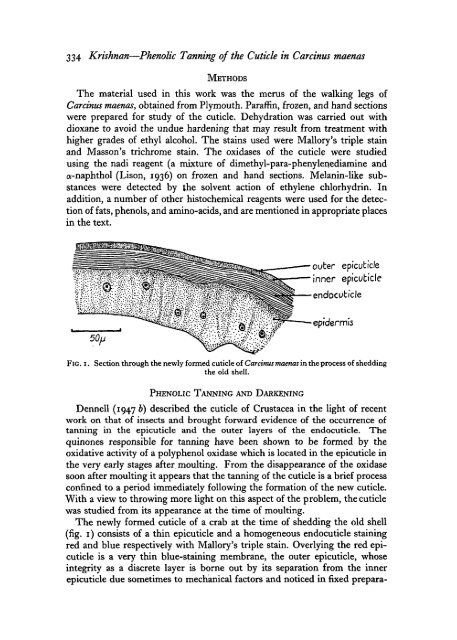Phenolic Tanning and Pigmentation of the Cuticle in Carcinus maenas
Phenolic Tanning and Pigmentation of the Cuticle in Carcinus maenas
Phenolic Tanning and Pigmentation of the Cuticle in Carcinus maenas
You also want an ePaper? Increase the reach of your titles
YUMPU automatically turns print PDFs into web optimized ePapers that Google loves.
334 Krishnan—<strong>Phenolic</strong> <strong>Tann<strong>in</strong>g</strong> <strong>of</strong> <strong>the</strong> <strong>Cuticle</strong> <strong>in</strong> Carc<strong>in</strong>us <strong>maenas</strong><br />
METHODS<br />
The material used <strong>in</strong> this work was <strong>the</strong> merus <strong>of</strong> <strong>the</strong> walk<strong>in</strong>g legs <strong>of</strong><br />
Carc<strong>in</strong>us <strong>maenas</strong>, obta<strong>in</strong>ed from Plymouth. Paraff<strong>in</strong>, frozen, <strong>and</strong> h<strong>and</strong> sections<br />
were prepared for study <strong>of</strong> <strong>the</strong> cuticle. Dehydration was carried out with<br />
dioxane to avoid <strong>the</strong> undue harden<strong>in</strong>g that may result from treatment with<br />
higher grades <strong>of</strong> ethyl alcohol. The sta<strong>in</strong>s used were Mallory's triple sta<strong>in</strong><br />
<strong>and</strong> Masson's trichrome sta<strong>in</strong>. The oxidases <strong>of</strong> <strong>the</strong> cuticle were studied<br />
us<strong>in</strong>g <strong>the</strong> nadi reagent (a mixture <strong>of</strong> dimethyl-para-phenylenediam<strong>in</strong>e <strong>and</strong><br />
a-naphthol (Lison, 1936) on frozen <strong>and</strong> h<strong>and</strong> sections. Melan<strong>in</strong>-like substances<br />
were detected by <strong>the</strong> solvent action <strong>of</strong> ethylene chlorhydr<strong>in</strong>. In<br />
addition, a number <strong>of</strong> o<strong>the</strong>r histochemical reagents were used for <strong>the</strong> detection<br />
<strong>of</strong> fats, phenols, <strong>and</strong> am<strong>in</strong>o-acids, <strong>and</strong> are mentioned <strong>in</strong> appropriate places<br />
<strong>in</strong> <strong>the</strong> text.<br />
outer epicubicle<br />
<strong>in</strong>ner epicuticle<br />
endocuticle<br />
epidermis<br />
FIG. 1. Section through <strong>the</strong> newly formed cuticle <strong>of</strong> Carc<strong>in</strong>us <strong>maenas</strong> <strong>in</strong> <strong>the</strong> process <strong>of</strong> shedd<strong>in</strong>g<br />
<strong>the</strong> old shell.<br />
PHENOLIC TANNING AND DARKENING<br />
Dennell (1947 b) described <strong>the</strong> cuticle <strong>of</strong> Crustacea <strong>in</strong> <strong>the</strong> light <strong>of</strong> recent<br />
work on that <strong>of</strong> <strong>in</strong>sects <strong>and</strong> brought forward evidence <strong>of</strong> <strong>the</strong> occurrence <strong>of</strong><br />
tann<strong>in</strong>g <strong>in</strong> <strong>the</strong> epicuticle <strong>and</strong> <strong>the</strong> outer layers <strong>of</strong> <strong>the</strong> endocuticle. The<br />
qu<strong>in</strong>ones responsible for tann<strong>in</strong>g have been shown to be formed by <strong>the</strong><br />
oxidative activity <strong>of</strong> a polyphenol oxidase which is located <strong>in</strong> <strong>the</strong> epicuticle <strong>in</strong><br />
<strong>the</strong> very early stages after moult<strong>in</strong>g. From <strong>the</strong> disappearance <strong>of</strong> <strong>the</strong> oxidase<br />
soon after moult<strong>in</strong>g it appears that <strong>the</strong> tann<strong>in</strong>g <strong>of</strong> <strong>the</strong> cuticle is a brief process<br />
conf<strong>in</strong>ed to a period immediately follow<strong>in</strong>g <strong>the</strong> formation <strong>of</strong> <strong>the</strong> new cuticle.<br />
With a view to throw<strong>in</strong>g more light on this aspect <strong>of</strong> <strong>the</strong> problem, <strong>the</strong> cuticle<br />
was studied from its appearance at <strong>the</strong> time <strong>of</strong> moult<strong>in</strong>g.<br />
The newly formed cuticle <strong>of</strong> a crab at <strong>the</strong> time <strong>of</strong> shedd<strong>in</strong>g <strong>the</strong> old shell<br />
(fig. 1) consists <strong>of</strong> a th<strong>in</strong> epicuticle <strong>and</strong> a homogeneous endocuticle sta<strong>in</strong><strong>in</strong>g<br />
red <strong>and</strong> blue respectively with Mallory's triple sta<strong>in</strong>. Overly<strong>in</strong>g <strong>the</strong> red epicuticle<br />
is a very th<strong>in</strong> blue-sta<strong>in</strong><strong>in</strong>g membrane, <strong>the</strong> outer epicuticle, whose<br />
<strong>in</strong>tegrity as a discrete layer is borne out by its separation from <strong>the</strong> <strong>in</strong>ner<br />
epicuticle due sometimes to mechanical factors <strong>and</strong> noticed <strong>in</strong> fixed prepara-
















